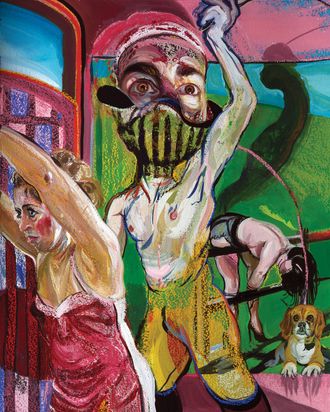
People are sometimes surprised that painter Natalie Frank is not more, say, goth, given the often depraved sexual theatricality of her artwork. In person, the rather sensible 38-year-old Yale graduate, who lives not far from Union Square, could easily pass as the vice-principal of your child’s grammar school. Last summer, when I visited her at her Bushwick studio, we talked about the research she did for a series of fleshy and direct portraits of dominatrices and their subs (she’d spent a lot of time in dungeons, she told me, and was interested in how the encounters seemed less about sex than enacting a rigorous therapeutic fantasy). And she revealed that her next project, a series of pastel illustrations, was based on Story of O, the anonymously written 64-year-old classic of the transgressive literary canon that coolly recounts a woman’s journey into sexual submission, complete with elaborate affirmative-consent rituals. (“Do I have your permission?” “I’m yours.”)
Frank’s dominatrix pictures showed at Rhona Hoffman Gallery in Chicago, paired with portraits she’d done of ballerinas. She’d been without New York representation for a while when her friend Sara Kay, the founder of the nonprofit Professional Organization for Women in the Arts, decided to open a space in Noho and scheduled an exhibition of the O pictures for this spring. But then, shortly before Christmas, Kay called Frank to cancel the show; it was, she felt, inappropriate given the social climate, since the broader culture, as well as the art world, was in the midst of what’s become known as the Reckoning. “It was a difficult decision, but I had a very real concern that the content of Story of O could act as a trigger for victims of abuse and violence,” Kay wrote me in an email, adding that she has recently become “a trusted colleague who women call when they’re experiencing gender bias or harassment in the workplace.”
Frank was stung. For one thing, she’d recently written an essay for ARTnews about her experiences with predatory men in the art world. But more to the point, “As a feminist, it’s your job to take risks,” she says. “As a supporter of women artists, it’s important to take those risks.”
She set out on a frantic search to find a new home for her pictures, contacting her network of fellow artists and curators. But for practical reasons (exhibitions are planned months in advance), as well as #MeToo exigencies (so why exactly would we want to do such a potentially controversial show?), the task would prove difficult.
I first encountered Frank’s work in 2015 at the Drawing Center and admired her darkly funny illustrations inspired by the retranslated, unsanitized Grimms’ Fairy Tales, which include incidents of incest, cannibalism, and rape. Claire Gilman, the chief curator at the Drawing Center, who worked with Frank on the show, says the traditional Brothers Grimm stories were told by mothers to their children as “tales of caution” about such very real concerns as being married off against your will. That said, the Grimm pictures don’t send “simplistic” feminist messages, Gilman says. They aren’t all “images of empowered women.”
Frank didn’t have a simplistic read of Story of O, either. She first picked it up at a bookshop when she was 15 and blushed constantly as she read it, while also, she admits, getting a kind of exhibitionistic thrill from doing so in public. It was a portable totem of boundary-breaking for the well-raised daughter of a Dallas pediatrician whose mother had accompanied her to life-drawing classes (she was too young to sketch naked people by herself!). Not incidentally, the head of the art department at Frank’s private high school refused to let her display her drawings, deeming them pornographic. “Until I got into Yale early,” Frank recalls drolly. At that point, she says, he allowed her to put up the pictures of women, but naked men were still off-limits. When I tell Frank I’d actually never thought to read O until I saw her work, she deadpans, “Well, you didn’t grow up a woman in the South.”
Frank rereads the book every year. The O of the title is a young fashion photographer who is taken to a château outside Paris by her lover, René, where, to prove her devotion to him, she allows herself to be chained up, whipped, continuously sexually assaulted by a number of rather beastly men, and then, apparently to up the ante on her sexual slavery, passed off to a family friend, who brands her and attaches a tag to her labia. After the book won a small French literary prize, the authorities considered charging its publisher with obscenity, and its fame spread. At one point in the 1960s, it was the most-read contemporary French novel outside of France. It caught the attention of anti-porn feminists, too, who thought it pandered to male fantasies and were horrified by O’s consent to violence. (Andrea Dworkin, in her 1974 book Woman Hating, calls it “a story of psychic cannibalism, demonic possession.”)
In 1994, the year before Frank discovered the book, the prominent journalist, editor, and translator Dominique Aury (née Anne Desclos), then 86, revealed herself as its author. The story of Story of O was that Aury had worried that her lover, Jean Paulhan, a noted philanderer and one of France’s preeminent editors and literary critics, would leave her. “I wasn’t young, I wasn’t pretty, it was necessary to find other weapons,” she told The New Yorker. And when he told her he didn’t think she was capable of writing erotica, she set out to prove him wrong. Frank calls it a “love letter of seduction.” (The two stayed lovers, and Paulhan not only helped get it published but wrote its introduction.)
Frank divided the book into 15 different drawings. “I only have one sex scene and one whipping scene,” she says. To Frank, while the book may keep track of O’s butt-plug size, “it’s not about sex. It’s about power and sexuality and identity and the imagination … She is the main actor in all of the lines.” The model for O in Frank’s pictures is a friend of a friend who reminded Frank of a “sidewalk Catherine Deneuve.” She looks like someone you might know, half-satiated and out of it, the only solid form in a woozy phantasmagoria. The model asked that she not be pictured fully nude, which, one could argue, makes the images kinkier.
Frank considers the book a testament to the power of a woman to manipulate the tropes of pornography to suit her ends, including proving her condescending lover wrong. And for what it’s worth, when Aury outed herself as its author, she stressed that “there is no reality here. Nobody could stand being treated like that. It’s entirely fantastic.”
“What I appreciate in what Natalie is doing is that we need more complex feminist stories in this #MeToo era,” says Veronica Roberts, curator of modern and contemporary art at the Blanton Museum at the University of Texas, Austin, which showed the Grimm series after the Drawing Center. “Why is it that female desire is something which is so scary?”
In her ARTnews piece, Frank wrote about how some men in the art world took her work as some DTF come-on directed at them. She detailed a studio visit from an older artist who first informed her that he could “tell what kind of girl” she was, before offering, “You know what you need? You need to be fucked up the ass.” By way of good-bye, he asked her to send him 25 nude self-portraits, as if his charisma had been so compellingly pungent that she’d swoon and fall seamlessly into the role of his sexual submissive. God only knows what he would’ve done had he seen the O pictures.
Eventually, one of Frank’s friends, the artist Nathaniel Mary Quinn, introduced her to Bill Powers and Erin Goldberger, who run the Half Gallery on the Upper East Side, and they agreed to do the show. It opens May 16. Powers admits that he’s a little nervous about it, that its sexuality “seems quite honestly a bit scary in these times.” But he ultimately believes the risk is worth it, even necessary, in the wake of controversies like the one around Dana Schutz’s painting of the lynched body of Emmett Till lying in its casket. “There is this hyperawareness that can lead to self-censorship in the art world, which I don’t think is a good thing,” he says. “And if you think that the purpose of literature is to educate and entertain, this body of work achieves that.”
“For the longest time we didn’t even want to talk about power and sex, and denied their connection, but that time is over,” Frank says. “I’ve been painting and drawing women grasping at sexual power for ten years. Now is the exact time to be having this conversation.”
*This article appears in the April 16, 2018, issue of New York Magazine. Subscribe Now!


